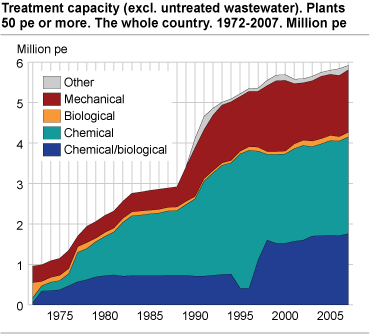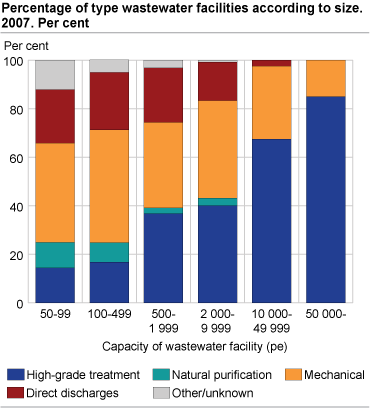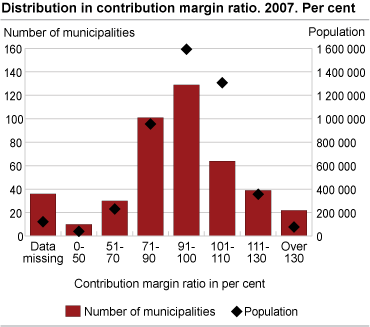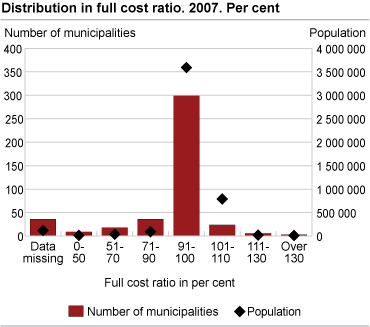Content
Published:
This is an archived release.
54 tonnes of heavy metals from wastewater
Estimates show that 54 tonnes of heavy metals and 3.7 tonnes of DEHP were discharged through the wastewater systems in 2007. Total discharges of two of the most serious heavy metals, cadmium and mercury, were 60 and 40 kg respectively. The treatment capacity increased in 2007, but less than the population growth.
The official wastewater statistics have previously only included discharges of phosphorous and nitrogen, but have been expanded for 2007 with some additional heavy metals (arsenic, cadmium, copper, mercury, nickel, lead and zinc) and one organic pollutant (DEHP).
Some discharges have been calculated based on information on the largest wastewater treatment plants in Norway, while the remainder have been estimated based on these reports. For heavy metals, these “large treatment plants” constitute around 50 per cent of total capacity of all Norwegian wastewater facilities. As for DEHP, the coverage is somewhat lower, covering around 37 per cent of the total capacity. Thus, the uncertainty in these estimates may be relatively extensive.
| Pollutant | Total discharge | ||||||||||||||||||||||||||||||||||||||
|---|---|---|---|---|---|---|---|---|---|---|---|---|---|---|---|---|---|---|---|---|---|---|---|---|---|---|---|---|---|---|---|---|---|---|---|---|---|---|---|
| Kilograms per year | |||||||||||||||||||||||||||||||||||||||
| Heavy metals | |||||||||||||||||||||||||||||||||||||||
| Heavy metals - total | 54 060 | ||||||||||||||||||||||||||||||||||||||
| Arsenic (As) | 660 | ||||||||||||||||||||||||||||||||||||||
| Cadmium (Cd) | 60 | ||||||||||||||||||||||||||||||||||||||
| Chromium (Cr) | 1 400 | ||||||||||||||||||||||||||||||||||||||
| Copper (Cu) | 13 000 | ||||||||||||||||||||||||||||||||||||||
| Mercury (Hg) | 40 | ||||||||||||||||||||||||||||||||||||||
| Nickel (Ni) | 3 700 | ||||||||||||||||||||||||||||||||||||||
| Lead (Pb) | 1 200 | ||||||||||||||||||||||||||||||||||||||
| Zinc (Zn) | 34 000 | ||||||||||||||||||||||||||||||||||||||
| Organic pollutants | |||||||||||||||||||||||||||||||||||||||
| DEHP | 3 700 | ||||||||||||||||||||||||||||||||||||||
1.6 per cent increase in total capacity
In 2007, the municipal wastewater facilities had a total capacity of around 6.3 million person equivalents (pe). This constitutes an increase of 0.1 million compared to the year before, and the reason is mainly due to an increase in chemical and/or biological treatment. The total capacity can be broken down into 5.9 million pe from wastewater treatment plants (treatment capacity) and 0.4 million pe originating from direct discharges (untreated wastewater).
Population growth higher than increase in connection with high-grade treatment
In 2007, 57 per cent of Norway’s population was connected to high-grade treatment plants - biological and/or chemical treatment. The reduction of around 1 per cent compared to last year is due to the fact that population growth (+1.2 per cent) has increased more than the increase in people connected to high-grade treatment (+0.5 per cent).
Estimates for 2007 show that a total of 2 776 municipal wastewater facilities (capacity 50 pe or more) were in operation for the whole or part of the year. These wastewater facilities treat wastewater for approximately 82 per cent of the population, which is one per cent less than last year. As with the reduction in people connected to high-grade treatment, this decrease is also due to higher population growth compared to the increase in inhabitants connected to wastewater facilities above 50 pe.
The general picture is a relatively high level of high-grade treatment among relatively large wastewater facilities, while mechanical treatment is more common among smaller wastewater facilities. For example, among wastewater facilities larger than 50 000 pe, high-grade constituted around 85 per cent of the facilities. In comparison, only 14 per cent was high-grade among facilities with capacity between 50-99 pe.
Increase in estimated discharges of phosphorous and nitrogen
For 2007, the discharges of phosphorous (tot-P) and nitrogen (tot-N) from municipal wastewater systems have been estimated at 785 tonnes and 12 600 tonnes respectively. The increase of 4 and 1 per cent respectively compared to 2006 was mainly due to improved and updated reporting.
For the country as a whole, the annual discharge per inhabitant was 0.20 kg for phosphorous and 3.27 kg for nitrogen. The treatment efficiencies for the wastewater sector as a whole have been estimated to 31 per cent for phosphorous and 69 per cent for nitrogen.
64 per cent of sewage sludge to agriculture
A total of 100 800 tonnes of dry weight sewage sludge was used in 2007, of which 64 per cent was used as soil improvement in agriculture and 12 per cent was used in parks and green spaces.
The costs of wastewater services
Wastewater fees are determined by the municipalities in accordance with the full cost principle. Local conditions such as patterns of built-up area, topography (terrain), bedrocks in the ground, the need for pumping stations and treatment requirements are factors behind the variation in fees.
In 2007, the total cost for all municipalities was NOK 4.9 billion. This constitutes an increase of 7.8 per cent compared to the year before (the figures for 2006 are updated). The costs related to the wastewater sector are made up of capital costs and operating costs. The figures for the entire country are calculated based on the data reported in KOSTRA, with estimates for data missing. The estimates are based on data reported last year and average figures from the groups of municipalities in KOSTRA.
A total of 62 per cent of the population live in municipalities with a contribution margin ratio between 90 and 110 per cent. This constitutes a change from 2006, when 51 per cent of the population lived in municipalities within the same interval. Simultaneous to this, the part of the population living in municipalities with a contribution margin ratio between 110 and 130 per cent fell from 24 per cent to 8 per cent. The full cost ratio reflects the ratio for the income from fees and the fee calculation basis. A full cost ratio above 100 per cent means that the incomes from fees are higher than the fee calculation basis.
The full cost ratio reflects the relationship between the income from fees and the fee calculation basis, and includes provisions for funds and purchases financed from funds. A total of 75 per cent of the municipalities have a full cost ratio between 90 and 100 per cent, and these municipalities are home to 94 per cent of the population.
Contact
-
Gisle Berge
E-mail: gisle.berge@ssb.no
tel.: (+47) 48 12 19 97




